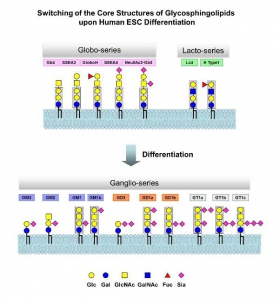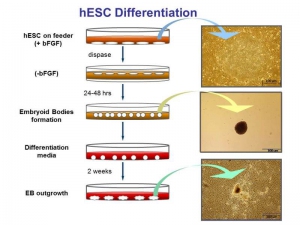
Combining the strengths in mass spectrometry analysis with stem cell technologies, an inter-disciplinary collaboration has unveiled a new way to pinpoint human embryonic stem cells. Scientists from Academia Sinica have identified a group of surface markers that can be used effectively in the study of embryonic and induced pluripotent stem cells (iPS) as well as cancer therapeutics. Some of these identified markers are glycosphingolipids that have never been found before in human embryonic stem cells. The editor of this publication is Dr. Senitiroh Hakomorim, who is a renowned scientist in glycomics
Led by Dr.
GSL is a type of glycolipids, which is basically a biological building block that contains lipid and sugar with sphingosine attached on the surface membrane of animal cells, including human beings. GSLs on cell surface often cluster together with other membrane components that send signals inside the cells to regulate cell adhesion and migration of cancer cells.
Specific family of GSLs which were once abundant on the cell surfaces of each one of us, say, when we were only days old as embryo, seemed to be switched off and replaced by another class of GSL later on. And then, years later, if cancer cells were unluckily found in one’s body, somehow certain GSLs originally present during the early embryonic life show up actively as well. This is exactly the behavior of a well known marker for human embryonic cell, SSEA-3, which was previously revealed on human breast cancer stem cells by the GRC research group(See Prior Report). On the other hand, globo-H is a type of GSLs found on many human cancers, but it makes appearance in human embryonic cells, as reported in this study. A current study with promising data underway in
 The team set out to resolve the mysteries of the alterations of GSLs. With a systematic approach, they started from a batch of human embryonic stem cell lines, and within 16 days of cell differentiation, they analyzed the changes of these GSLs with mass spectrometry analysis. At least, a total of seven types of GSLs were identified in human embryonic stem cells. By the core structure of these molecules, they distinguished such GSLs as globo- and lacto-series. To their surprises, there was an almost complete “makeover” of the GSLs when the original embryonic cells differentiated to the more developed human body cells. It turned out that the core structure of GSLs of embryonic stem cells made a switch from globo- and lacto-series into a ganglio-series structure upon differentiation. In other word, the globo- and lacto-series of GSLs became rare and replaced by ganglio- series.
The team set out to resolve the mysteries of the alterations of GSLs. With a systematic approach, they started from a batch of human embryonic stem cell lines, and within 16 days of cell differentiation, they analyzed the changes of these GSLs with mass spectrometry analysis. At least, a total of seven types of GSLs were identified in human embryonic stem cells. By the core structure of these molecules, they distinguished such GSLs as globo- and lacto-series. To their surprises, there was an almost complete “makeover” of the GSLs when the original embryonic cells differentiated to the more developed human body cells. It turned out that the core structure of GSLs of embryonic stem cells made a switch from globo- and lacto-series into a ganglio-series structure upon differentiation. In other word, the globo- and lacto-series of GSLs became rare and replaced by ganglio- series.
They went on to show that such a drastic switch occurred as a result of concerted changes in the expression levels of key molecules involved in the manufacture of GSLs. It is very likely that during the later time, when a human body is not providing a proper living environment for the cells, then triggers of some sort were turned on and thus globo- and lacto-series GSLs appear again.
Therefore, this study has provided new markers for identification of human embryonic stem cells and for detection and development of new treatment for cancers. It also offers a promising tool for identifying the iPS. iPS is a newly developed stem cell technology which can be thought of as a cellular re-programming. Scientists have already proved it possible to develop stem cells from mature differentiated cells. One of the obstacles for IPS studies appears to be the difficulties in distinguishing the fully reprogrammed from partially reprogrammed cells or from regular cells. Thus, these markers should come handy for such tasks.
“Since one of the GSLs, globo H, has been proved to be a promising target for breast cancer therapeutics, this finding has truly shed even more lights for cancer detection and treatments.”, commented Dr. Alice L. Yu.
Details of the publication can be found in: http://www.pnas.org/content/early/2010/12/10/1007290108.abstract